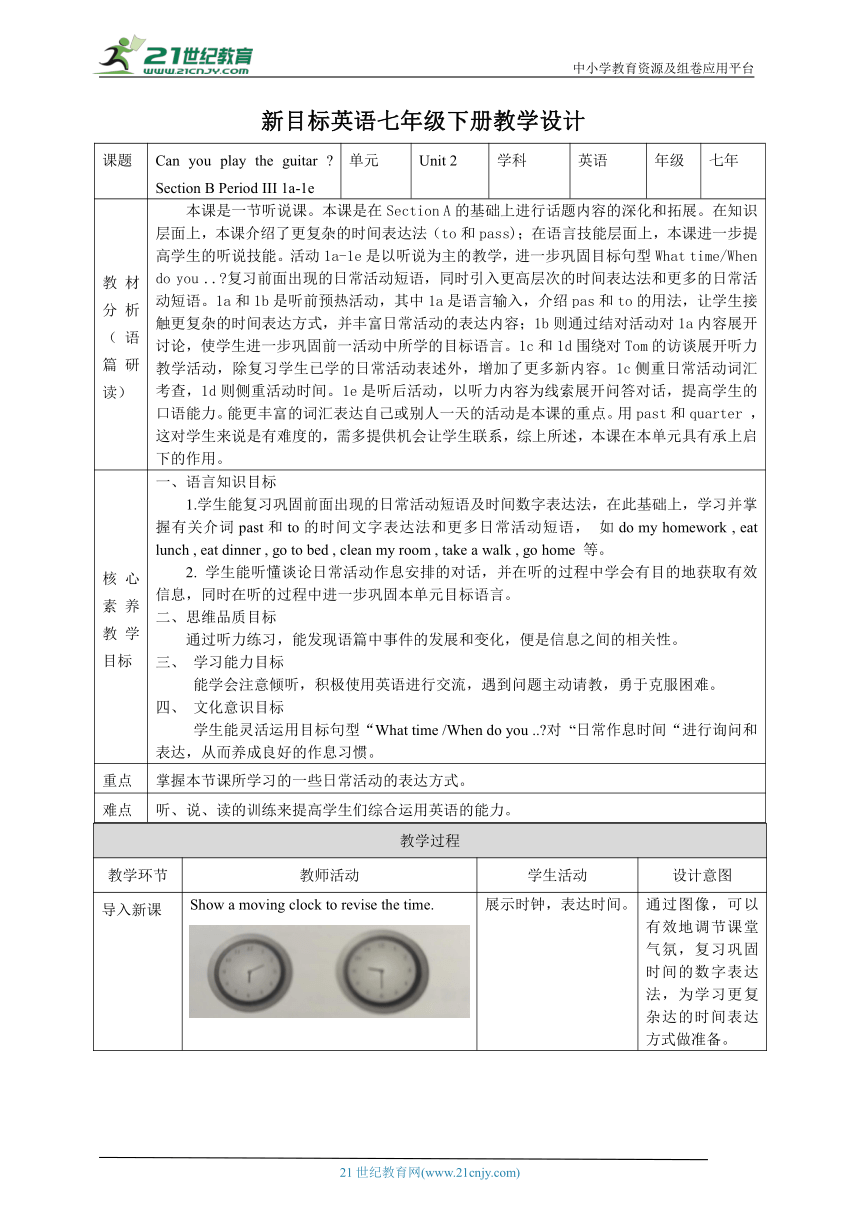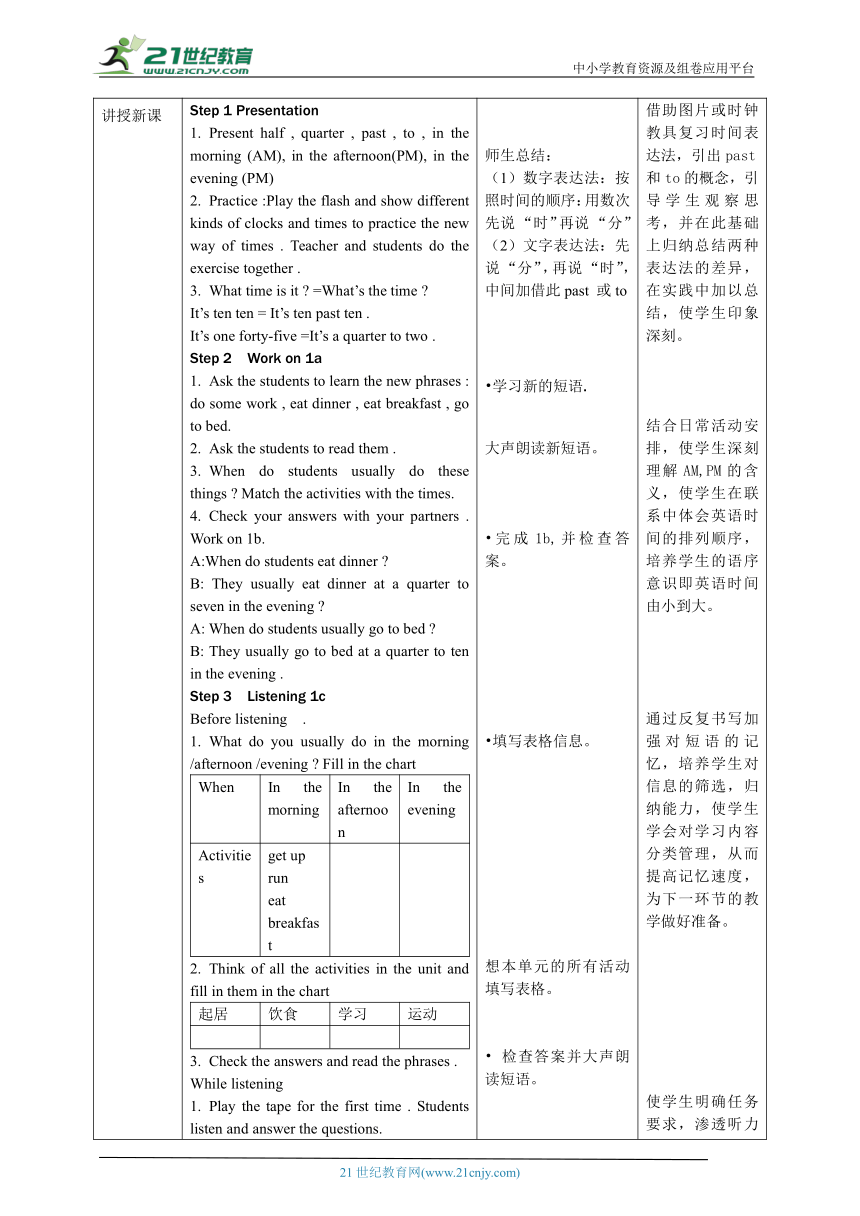【核心素养目标】Unit 2 What time do you go to school Section B 1a-1e 表格式教学设计
文档属性
| 名称 | 【核心素养目标】Unit 2 What time do you go to school Section B 1a-1e 表格式教学设计 |  | |
| 格式 | zip | ||
| 文件大小 | 1.6MB | ||
| 资源类型 | 试卷 | ||
| 版本资源 | 人教新目标(Go for it)版 | ||
| 科目 | 英语 | ||
| 更新时间 | 2023-02-24 20:00:20 | ||
图片预览


文档简介
中小学教育资源及组卷应用平台
新目标英语七年级下册教学设计
课题 Can you play the guitar Section B Period III 1a-1e 单元 Unit 2 学科 英语 年级 七年
教材分析(语篇研读) 本课是一节听说课。本课是在Section A的基础上进行话题内容的深化和拓展。在知识层面上,本课介绍了更复杂的时间表达法(to和pass);在语言技能层面上,本课进一步提高学生的听说技能。活动1a-1e是以听说为主的教学,进一步巩固目标句型What time/When do you .. 复习前面出现的日常活动短语,同时引入更高层次的时间表达法和更多的日常活动短语。1a和1b是听前预热活动,其中1a是语言输入,介绍pas和to的用法,让学生接触更复杂的时间表达方式,并丰富日常活动的表达内容;1b则通过结对活动对1a内容展开讨论,使学生进一步巩固前一活动中所学的目标语言。1c和1d围绕对Tom的访谈展开听力教学活动,除复习学生已学的日常活动表述外,增加了更多新内容。1c侧重日常活动词汇考查,1d则侧重活动时间。1e是听后活动,以听力内容为线索展开问答对话,提高学生的口语能力。能更丰富的词汇表达自己或别人一天的活动是本课的重点。用past和quarter ,这对学生来说是有难度的,需多提供机会让学生联系,综上所述,本课在本单元具有承上启下的作用。
核心素养教学目标 一、语言知识目标1.学生能复习巩固前面出现的日常活动短语及时间数字表达法,在此基础上,学习并掌握有关介词past和to的时间文字表达法和更多日常活动短语, 如do my homework , eat lunch , eat dinner , go to bed , clean my room , take a walk , go home 等。 2. 学生能听懂谈论日常活动作息安排的对话,并在听的过程中学会有目的地获取有效信息,同时在听的过程中进一步巩固本单元目标语言。 二、思维品质目标通过听力练习,能发现语篇中事件的发展和变化,便是信息之间的相关性。 学习能力目标 能学会注意倾听,积极使用英语进行交流,遇到问题主动请教,勇于克服困难。 文化意识目标 学生能灵活运用目标句型“What time /When do you .. 对 “日常作息时间“进行询问和表达,从而养成良好的作息习惯。
重点 掌握本节课所学习的一些日常活动的表达方式。
难点 听、说、读的训练来提高学生们综合运用英语的能力。
教学过程
教学环节 教师活动 学生活动 设计意图
导入新课 Show a moving clock to revise the time. 展示时钟,表达时间。 通过图像,可以有效地调节课堂气氛,复习巩固时间的数字表达法,为学习更复杂达的时间表达方式做准备。
讲授新课 Step 1 Presentation Present half , quarter , past , to , in the morning (AM), in the afternoon(PM), in the evening (PM)Practice :Play the flash and show different kinds of clocks and times to practice the new way of times . Teacher and students do the exercise together . What time is it =What’s the time It’s ten ten = It’s ten past ten . It’s one forty-five =It’s a quarter to two . Step 2 Work on 1a Ask the students to learn the new phrases : do some work , eat dinner , eat breakfast , go to bed. Ask the students to read them . When do students usually do these things Match the activities with the times. Check your answers with your partners . Work on 1b. A:When do students eat dinner B: They usually eat dinner at a quarter to seven in the evening A: When do students usually go to bed B: They usually go to bed at a quarter to ten in the evening . Step 3 Listening 1c Before listening . What do you usually do in the morning /afternoon /evening Fill in the chart When In the morning In the afternoon In the evening Activities get up run eat breakfast Think of all the activities in the unit and fill in them in the chart 起居饮食学习运动Check the answers and read the phrases . While listening Play the tape for the first time . Students listen and answer the questions. Who is talking about his day Does Tom get up early When does he get up When does he exercise , in the morning or in the evening What sports does he do every day Work on 1c. Listen and circle the activities you hear . Work on 1d. Listen again . Write the time next to the activities you circled in 1c. Check the answers . Step 4 Pair work: Talk about Tom’s day (1e) A:When does Tom usually get up B: He usually gets up at half past five . A:What time does Tom usually .. B: He usually (does ) ... Step 5 Retell Tom’s day Tom gets up early . He gets up at half past five . He runs at six . He eats breakfast at seven .. Step 6: Talk about your day . From morning to evening , what do you usually do What time do the things Activities When get up at 6:00 in the morning . ......I have a(n) ____ day . (busy , exciting , relaxing , interesting , boring ...) 师生总结:数字表达法:按照时间的顺序:用数次先说 “时”再说 “分”文字表达法:先说 “分”,再说 “时”,中间加借此past 或to 学习新的短语. 大声朗读新短语。 完成1b,并检查答案。 填写表格信息。 想本单元的所有活动填写表格。 检查答案并大声朗读短语。 听磁带,回答问题。 完成1c 完成1d. 检查答案。 完成1e 。 复述Tom的一天。 谈论你一天的活动,并表达。 借助图片或时钟教具复习时间表达法,引出past和to的概念,引导学生观察思考,并在此基础上归纳总结两种表达法的差异,在实践中加以总结,使学生印象深刻。 结合日常活动安排,使学生深刻理解AM,PM的含义,使学生在联系中体会英语时间的排列顺序,培养学生的语序意识即英语时间由小到大。 通过反复书写加强对短语的记忆,培养学生对信息的筛选,归纳能力,使学生学会对学习内容分类管理,从而提高记忆速度,为下一环节的教学做好准备。 使学生明确任务要求,渗透听力策略,听力不仅是练耳的过程,更是需要动脑思考的过程。 设计不同的听力任务,任务布置明确,由浅入深,层层递进,符合学生认知规律。 要求学生使用时间文字表达法, 在不同的语境中巩固许哦学,学以致用,由口语会话到变换人称的复述联系,可帮助学生坚实的语言基础。
课堂练习 单项选择-What’s the time -_____half past nine . Its B. It’s C. This is D. They’re We go to ______ at six thirty in the morning . the school B. a school C . school D . schools It’s ten o’clock . I must go ______ . to home B. home C . my home D. his home What time does Jane _____ after school do her homework B. dose her homework C do her homeworks D. does her homework She _____ goes to bed after 12 o’clock because she can’t go home before 12 o’clock . always B. never C. sometimes D. often I ______at ten o’clock in the evening . has breakfast B. gets up C go to bed D. watch morning news
课堂小结 通过本节课的学习,我们进一步巩固了目标句型 “What time .. /When do you .. 复习了前面出现的日常活动短语,同时学习了更多的关于日常活动的短语,如:do my homework , eat lunch , eat dinner , go to bed , clean my room , take a walk , go home 等。 复习了时间数字表达法,在此基础上主要学习了介词past 和to 的用法,引出更高层次的时间文字表达法,其中半小时和15分钟的特殊表达法为half 和啊quarter, 现在相信大家应该能够使用更加丰富的日常活动和多种时间表达方式谈论日常作息安排了。
板书 Unit 2 What time do you go to school Section B 1a-1e整点数 o’clock 分钟数 past 整点数half past 整点数差分钟数 to 下一整点数15 分钟 a quarter past 整点数45 分钟 a quarter to 下一整点数
f
21世纪教育网 www.21cnjy.com 精品试卷·第 2 页 (共 2 页)
HYPERLINK "http://www.21cnjy.com/" 21世纪教育网(www.21cnjy.com)
新目标英语七年级下册教学设计
课题 Can you play the guitar Section B Period III 1a-1e 单元 Unit 2 学科 英语 年级 七年
教材分析(语篇研读) 本课是一节听说课。本课是在Section A的基础上进行话题内容的深化和拓展。在知识层面上,本课介绍了更复杂的时间表达法(to和pass);在语言技能层面上,本课进一步提高学生的听说技能。活动1a-1e是以听说为主的教学,进一步巩固目标句型What time/When do you .. 复习前面出现的日常活动短语,同时引入更高层次的时间表达法和更多的日常活动短语。1a和1b是听前预热活动,其中1a是语言输入,介绍pas和to的用法,让学生接触更复杂的时间表达方式,并丰富日常活动的表达内容;1b则通过结对活动对1a内容展开讨论,使学生进一步巩固前一活动中所学的目标语言。1c和1d围绕对Tom的访谈展开听力教学活动,除复习学生已学的日常活动表述外,增加了更多新内容。1c侧重日常活动词汇考查,1d则侧重活动时间。1e是听后活动,以听力内容为线索展开问答对话,提高学生的口语能力。能更丰富的词汇表达自己或别人一天的活动是本课的重点。用past和quarter ,这对学生来说是有难度的,需多提供机会让学生联系,综上所述,本课在本单元具有承上启下的作用。
核心素养教学目标 一、语言知识目标1.学生能复习巩固前面出现的日常活动短语及时间数字表达法,在此基础上,学习并掌握有关介词past和to的时间文字表达法和更多日常活动短语, 如do my homework , eat lunch , eat dinner , go to bed , clean my room , take a walk , go home 等。 2. 学生能听懂谈论日常活动作息安排的对话,并在听的过程中学会有目的地获取有效信息,同时在听的过程中进一步巩固本单元目标语言。 二、思维品质目标通过听力练习,能发现语篇中事件的发展和变化,便是信息之间的相关性。 学习能力目标 能学会注意倾听,积极使用英语进行交流,遇到问题主动请教,勇于克服困难。 文化意识目标 学生能灵活运用目标句型“What time /When do you .. 对 “日常作息时间“进行询问和表达,从而养成良好的作息习惯。
重点 掌握本节课所学习的一些日常活动的表达方式。
难点 听、说、读的训练来提高学生们综合运用英语的能力。
教学过程
教学环节 教师活动 学生活动 设计意图
导入新课 Show a moving clock to revise the time. 展示时钟,表达时间。 通过图像,可以有效地调节课堂气氛,复习巩固时间的数字表达法,为学习更复杂达的时间表达方式做准备。
讲授新课 Step 1 Presentation Present half , quarter , past , to , in the morning (AM), in the afternoon(PM), in the evening (PM)Practice :Play the flash and show different kinds of clocks and times to practice the new way of times . Teacher and students do the exercise together . What time is it =What’s the time It’s ten ten = It’s ten past ten . It’s one forty-five =It’s a quarter to two . Step 2 Work on 1a Ask the students to learn the new phrases : do some work , eat dinner , eat breakfast , go to bed. Ask the students to read them . When do students usually do these things Match the activities with the times. Check your answers with your partners . Work on 1b. A:When do students eat dinner B: They usually eat dinner at a quarter to seven in the evening A: When do students usually go to bed B: They usually go to bed at a quarter to ten in the evening . Step 3 Listening 1c Before listening . What do you usually do in the morning /afternoon /evening Fill in the chart When In the morning In the afternoon In the evening Activities get up run eat breakfast Think of all the activities in the unit and fill in them in the chart 起居饮食学习运动Check the answers and read the phrases . While listening Play the tape for the first time . Students listen and answer the questions. Who is talking about his day Does Tom get up early When does he get up When does he exercise , in the morning or in the evening What sports does he do every day Work on 1c. Listen and circle the activities you hear . Work on 1d. Listen again . Write the time next to the activities you circled in 1c. Check the answers . Step 4 Pair work: Talk about Tom’s day (1e) A:When does Tom usually get up B: He usually gets up at half past five . A:What time does Tom usually .. B: He usually (does ) ... Step 5 Retell Tom’s day Tom gets up early . He gets up at half past five . He runs at six . He eats breakfast at seven .. Step 6: Talk about your day . From morning to evening , what do you usually do What time do the things Activities When get up at 6:00 in the morning . ......I have a(n) ____ day . (busy , exciting , relaxing , interesting , boring ...) 师生总结:数字表达法:按照时间的顺序:用数次先说 “时”再说 “分”文字表达法:先说 “分”,再说 “时”,中间加借此past 或to 学习新的短语. 大声朗读新短语。 完成1b,并检查答案。 填写表格信息。 想本单元的所有活动填写表格。 检查答案并大声朗读短语。 听磁带,回答问题。 完成1c 完成1d. 检查答案。 完成1e 。 复述Tom的一天。 谈论你一天的活动,并表达。 借助图片或时钟教具复习时间表达法,引出past和to的概念,引导学生观察思考,并在此基础上归纳总结两种表达法的差异,在实践中加以总结,使学生印象深刻。 结合日常活动安排,使学生深刻理解AM,PM的含义,使学生在联系中体会英语时间的排列顺序,培养学生的语序意识即英语时间由小到大。 通过反复书写加强对短语的记忆,培养学生对信息的筛选,归纳能力,使学生学会对学习内容分类管理,从而提高记忆速度,为下一环节的教学做好准备。 使学生明确任务要求,渗透听力策略,听力不仅是练耳的过程,更是需要动脑思考的过程。 设计不同的听力任务,任务布置明确,由浅入深,层层递进,符合学生认知规律。 要求学生使用时间文字表达法, 在不同的语境中巩固许哦学,学以致用,由口语会话到变换人称的复述联系,可帮助学生坚实的语言基础。
课堂练习 单项选择-What’s the time -_____half past nine . Its B. It’s C. This is D. They’re We go to ______ at six thirty in the morning . the school B. a school C . school D . schools It’s ten o’clock . I must go ______ . to home B. home C . my home D. his home What time does Jane _____ after school do her homework B. dose her homework C do her homeworks D. does her homework She _____ goes to bed after 12 o’clock because she can’t go home before 12 o’clock . always B. never C. sometimes D. often I ______at ten o’clock in the evening . has breakfast B. gets up C go to bed D. watch morning news
课堂小结 通过本节课的学习,我们进一步巩固了目标句型 “What time .. /When do you .. 复习了前面出现的日常活动短语,同时学习了更多的关于日常活动的短语,如:do my homework , eat lunch , eat dinner , go to bed , clean my room , take a walk , go home 等。 复习了时间数字表达法,在此基础上主要学习了介词past 和to 的用法,引出更高层次的时间文字表达法,其中半小时和15分钟的特殊表达法为half 和啊quarter, 现在相信大家应该能够使用更加丰富的日常活动和多种时间表达方式谈论日常作息安排了。
板书 Unit 2 What time do you go to school Section B 1a-1e整点数 o’clock 分钟数 past 整点数half past 整点数差分钟数 to 下一整点数15 分钟 a quarter past 整点数45 分钟 a quarter to 下一整点数
f
21世纪教育网 www.21cnjy.com 精品试卷·第 2 页 (共 2 页)
HYPERLINK "http://www.21cnjy.com/" 21世纪教育网(www.21cnjy.com)
同课章节目录
- Unit 1 Can you play the guitar?
- Section A
- Section B
- Unit 2 What time do you go to school?
- Section A
- Section B
- Unit 3 How do you get to school?
- Section A
- Section B
- Unit 4 Don't eat in class.
- Section A
- Section B
- Unit 5 Why do you like pandas?
- Section A
- Section B
- Unit 6 I'm watching TV.
- Section A
- Section B
- Review of Units 1-6
- Unit 7 It's raining!
- Section A
- Section B
- Unit 8 Is there a post office near here?
- Section A
- Section B
- Unit 9 What does he look like?
- Section A
- Section B
- Unit 10 I'd like some noodles.
- Section A
- Section B
- Unit 11 How was your school trip?
- Section A
- Section B
- Unit 12 What did you do last weekend?
- Section A
- Section B
